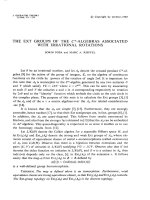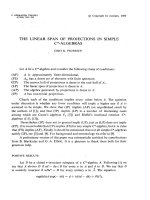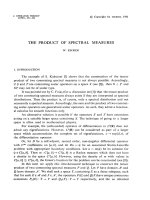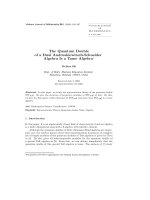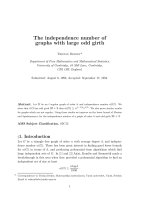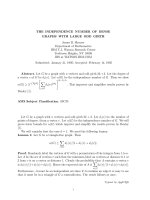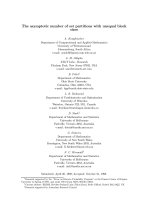Báo cáo toán học: "The spectral radius and the maximum degree of irregular graphs" doc
Bạn đang xem bản rút gọn của tài liệu. Xem và tải ngay bản đầy đủ của tài liệu tại đây (125.4 KB, 10 trang )
The spectral radius and the maximum degree of
irregular graphs
Sebastian M. Cioab˘a
∗
Department of Mathematics
University of California, San Diego
La Jolla, CA 92093-0112
Submitted: Jan 20, 2007; Accepted: May 3, 2007; Published: May 23, 2007
MR Subject Classifications: 05C50, 15A18
Abstract
Let G be an irregular graph on n vertices with maximum degree ∆ and diameter
D. We show that
∆ − λ
1
>
1
nD
,
where λ
1
is the largest eigenvalue of the adjacency matrix of G. We also study the
effect of adding or removing few edges on the spectral radius of a regular graph.
1 Preliminaries
Our graph notation is standard (see West [22]). For a graph G, we denote by λ
i
(G) the
i-th largest eigenvalue of its adjacency matrix and we call λ
1
(G) the spectral radius of
G. If G is connected, then the positive eigenvector of norm 1 corresponding to λ
1
(G) is
called the principal eigenvector of G.
The spectral radius of a connected graph has been well studied. Results in the lit-
erature connect it with the chromatic number, the independence number and the clique
number of a connected graph [9, 11, 12, 17, 23]. Recently, it has been shown that the
spectral radius also plays an important role in modeling virus propagation in networks
[10, 21].
In this paper, we are interested in the connection between the spectral radius and the
maximum degree ∆ of a connected graph G. In particular, we study the spectral radius of
graphs obtained from ∆-regular graphs on n vertices by deleting a small number of edges
or loops. The Erd˝os-R´enyi graph ER(q) is an example of such a graph, see [9, 15] and the
references within for more details on its spectral radius and other interesting properties.
∗
Research partially supported by an NSERC postdoctoral fellowship.
the electronic journal of combinatorics 14 (2007), #R38 1
It is a well known fact that λ
1
(G) ≤ ∆(G) with equality if and only if G is regular. It
is natural to ask how small ∆(G) − λ
1
(G) can be when G is irregular.
Cioab˘a, Gregory and Nikiforov [5] proved that if G is an irregular graph on n vertices,
with maximum degree ∆ and diameter D, then
∆ − λ
1
>
1
n(D +
1
n∆−2m
)
≥
1
nD + n
,
where m is the number of edges of G. This result improved previous work of Stevanovi´c
[20], Zhang [24] and Alon and Sudakov [1].
In [5], the authors conjecture that
∆ − λ
1
>
1
nD
. (1)
In this paper, we prove this conjecture. Using inequality (1), we improve some recent
results of Nikiforov [16] regarding the spectral radius of a subgraph of a regular graph. We
also investigate the spectral radius of a graph obtained from a regular graph by adding
an edge.
For recent results connecting the spectral radius of a general (not necessarily regular)
graph G and that of a subgraph of G, see [16].
2 The spectral radius and the maximum degree
The following theorem is the main result of this section.
Theorem 2.1. Let G be a connected irregular graph with n vertices, maximum degree ∆
and diameter D. Then
∆ − λ
1
(G) >
1
nD
.
Proof. Let x be the principal eigenvector of G. Let s be a vertex of G such that x
s
=
max
i∈[n]
x
i
. Since G is not regular, it follows that x
s
>
1
√
n
.
If the degree of s is not ∆, then
λ
1
x
s
=
j∼s
x
j
≤ (∆ − 1)x
s
which implies ∆ − λ
1
≥ 1 >
1
nD
and proves the theorem.
From now on, we will assume that the degree of s is ∆. Our proof is now split in two
cases depending on the number of vertices of G whose degree is not ∆:
Case 1) G contains at least two vertices whose degree is not ∆.
Let u and v be two vertices of G whose degree is not ∆. Let P : u = i
0
, i
1
, . . . , i
r
= s
be a shortest path from u to s in G. Obviously, r ≤ D. Let Q be a shortest path from v
to s in G. Let t be the smallest index j such that i
j
is on Q. Obviously, t ∈ {0, . . . , r}.
the electronic journal of combinatorics 14 (2007), #R38 2
If t = 0, then the distance from u to s is at most D − 1 (this means r ≤ D − 1), and
applying a similar argument to the one in [5], we obtain that
∆ − λ
1
(G) = ∆
n
j=1
x
2
j
−
kl∈E(G)
2x
k
x
l
=
n
i=1
(∆ − d
i
)x
2
i
+
kl∈E(G)
(x
k
− x
l
)
2
≥ x
2
u
+
r−1
j=0
(x
i
j+1
− x
i
j
)
2
≥
x
u
+
r−1
j=0
(x
i
j+1
− x
i
j
)
2
r + 1
=
x
2
i
r
r + 1
>
1
nD
.
If t ≥ 1, we may assume without any loss of generality that t = d(u, i
t
) ≥ d(v, i
t
).
Let Q
v,i
t
denote the sub-path of Q which connects v to i
t
. Using the Cauchy-Schwarz
inequality, it follows that
∆ − λ
1
(G) =
n
i=1
(∆ − d
i
)x
2
i
+
kl∈E(G)
(x
k
− x
l
)
2
≥ x
2
u
+ x
2
v
+
kl∈E(G)
(x
k
− x
l
)
2
≥ (x
2
u
+
t−1
j=0
(x
i
j
− x
i
j+1
)
2
) + (x
2
v
+
kl∈E(Q
v,i
t
)
(x
k
− x
l
)
2
) +
r
j=t
(x
i
j
− x
i
j+1
)
2
≥
x
2
i
t
t + 1
+
x
2
i
t
d(v, i
t
) + 1
+
(x
i
t
− x
s
)
2
r − t
≥
2x
2
i
t
t + 1
+
(x
s
− x
i
t
)
2
r − t
.
The right hand-side is a quadratic function in x
i
t
which attains its minimum when x
i
t
=
(t+1)x
s
2r−t+1
. This implies that
∆ − λ
1
(G) >
2x
2
s
2r −t + 1
≥
x
2
s
r
since t ≥ 1. Because x
s
>
1
√
n
and r ≤ D, we obtain
∆ − λ
1
(G) >
1
nD
.
This finishes the proof in the case that G has at least two vertices whose degree is not ∆.
Case 2) G contains exactly one vertex whose degree is not ∆.
Let w be a vertex whose principal eigenvector entry is minimum. Then d
w
< ∆
because
∆x
w
> λ
1
x
w
=
j∼w
x
j
≥ d
w
x
w
.
the electronic journal of combinatorics 14 (2007), #R38 3
Recall that x
s
= max
i∈[n]
x
i
. Let γ =
x
s
x
w
. We may assume that γ > D. Otherwise, by
summing the equalities λ
1
x
i
=
j∼i
x
j
over all i ∈ [n] we have
∆ − λ
1
=
(∆ − d
w
)x
w
n
i=1
x
i
>
x
w
nx
s
=
1
nγ
≥
1
nD
which proves the theorem.
We may also assume that d(w, s) = D because otherwise by applying an argument
similar to the one of the previous case, we can easily finish the proof of the theorem.
We claim there exists j ∼ s such that x
j
<
1
√
n
. Otherwise, let j ∼ s such that
d(j, w) = D − 1. Then applying the argument from the previous case gives
∆ − λ
1
>
x
2
j
D
>
1
nD
which finishes the proof of the theorem.
Since x
j
<
1
√
n
and j ∼ s, we have
λ
1
x
s
=
l∼s
x
l
< (∆ −1)x
s
+
1
√
n
which implies
∆ − λ
1
> 1 −
1
x
s
√
n
.
If the right-hand side is at least
1
nD
, then we are done. Otherwise, 1 −
1
x
s
√
n
<
1
nD
implies
x
s
<
D
√
n
nD − 1
. (2)
Since x
s
= max
i∈[n]
x
i
, x
w
= min
i∈[n]
x
i
, we have that
(n − 1)x
2
s
+ x
2
w
≥
n
l=1
x
2
l
= 1
which implies
x
2
w
≥ 1 −
(n − 1)nD
2
(nD − 1)
2
=
(nD − 1)
2
− (n − 1)nD
2
(nD − 1)
2
=
(D
2
− 2D)n + 1
(nD − 1)
2
. (3)
Assume D ≥ 3. From (2) and (3), we get that
γ
2
=
x
2
s
x
2
w
<
D
2
n
(D
2
− 2D)n + 1
< D
2
.
Thus, γ < D which is a contradiction with the earlier assumption that γ > D. This
proves the theorem for D ≥ 3.
the electronic journal of combinatorics 14 (2007), #R38 4
For D = 2, looking at the square of the adjacency matrix of G we get
λ
2
1
x
s
≤ (∆
2
− 1)x
s
+ x
w
(4)
which implies
λ
2
1
≤ ∆
2
− 1 +
1
γ
< ∆
2
−
1
2
since γ ≥ 2. Note that inequality (4) holds because there is at least one path of length 2
from s to w.
Thus, λ
1
≤
∆
2
−
1
2
< ∆ −
1
4∆
.
If n ≥ 2∆, then we are done. Suppose then that n < 2∆. Then the vertex s has at
least two neighbours at distance 1 from the vertex w. We deduce that
λ
2
1
x
s
≤ (∆
2
− 2)x
s
+ 2x
w
which implies
λ
2
1
≤ ∆
2
− 2 +
2
γ
≤ ∆
2
− 1.
Thus,
λ
1
≤
√
∆
2
− 1 < ∆ −
1
2∆
< ∆ −
1
nD
which completes the proof of the theorem.
Because λ
1
(G) = ∆(G) when G is regular, the following result is an immediate conse-
quence of Theorem 2.1.
Corollary 2.2. Let G be a ∆-regular graph and e be an edge of G such that G \ e is
connected. Then
2
n
> ∆ −λ
1
(G \ e) >
1
nD
,
where D is the diameter of G \e.
The previous results improve Theorems 4-6 obtained by Nikiforov in a recent paper
[16].
If f, g : N → [0, +∞) we write f(n) = O(g(n)) if there is c > 0 and n
0
> 0 such
that f(n) ≤ cg(n) for n ≥ n
0
and we write f(n) = Θ(g(n)) if f(n) = O(g(n)) and
g(n) = O(f(n)).
Under the same hypothesis as the previous corollary, if ∆ ≥ 3 is fixed and G \ e is
connected, then the diameter D of G\e is at least log
∆−1
n+O(1). In this case, we obtain
the following estimates
2
n
> ∆ −λ
1
(G \ e) > O
1
n log
∆−1
n
.
It seems likely that the upper bound gives the right order of magnitude for ∆ −λ
1
(G \e),
but proving this fact is an open problem.
the electronic journal of combinatorics 14 (2007), #R38 5
If ∆ = Θ(n) and G \ e is connected, then the diameter D of G \ e is O(1). To see
this consider a path i
0
, . . . , i
D
of length D in G \ e. For 0 ≤ j ≤ D, let N
j
denote the
neighborhood of vertex j in G \ e. It follows that for j ≡ 0 (mod 3), 0 ≤ j ≤ D, the sets
N
j
are pairwise disjoint. Also, for all but at most two j’s, we have |N
j
| = ∆. These facts
imply that
n ≥
j≡0 (mod 3)
|N
j
| >
D + 1
3
− 2
∆ + 2(∆ − 1) =
∆(D + 1)
3
− 2.
Thus,
D <
3(n + 2)
∆
= O(1).
Hence, in this case, our estimates imply that
∆ − λ
1
(G \e) = Θ
1
n
.
Note that the previous argument can be also used to show that if ∆ = Θ(n) and H is
a connected graph obtained from a ∆-regular graph on n vertices by deleting a constant
number of edges, then
∆ − λ
1
(H) = Θ
1
n
.
3 Adding an edge to a regular graph
In this section, we analyze the effect of adding an edge on the spectral radius of a regular
graph. We need different techniques in this case because the spectral radius will be closer
to the minimum degree than to the maximum degree of the graph.
Theorem 3.1. Let H be a connected, k-regular graph and e /∈ E(H). If G is the graph
obtained from H by adding the edge e and k − λ
2
(H) > 1, then
2
n
·
1 +
1
k − λ
2
(H) − 1
> λ
1
(G) − λ
1
(H) >
2
n
·
1 +
1
2(k + 2)
. (5)
Proof. The lower bound follows by applying the following result obtained by Nikiforov
[18]. See also [4] for related results.
Theorem 3.2. Let G be an irregular graph with n vertices and m edges having maximum
degree ∆. If G has at least two vertices of degree ∆ and at least two vertices of degree less
than ∆, then
λ
1
(G) >
2m
n
+
1
2m + n
For the upper bound, we use the following result of Maas [14] (see also Theorem 6.4.1
in [6] and [3]).
the electronic journal of combinatorics 14 (2007), #R38 6
Theorem 3.3 (Maas [14]). Let x be the principal eigenvector of a graph H and let i
and j be two non-adjacent vertices in H. Then
λ
1
(H + ij) − λ
1
(H) < 1 + δ − β, (6)
where
β = λ
1
(H) − λ
2
(H)
and δ satisfies the equation
δ(1 + δ)(2 + δ)
(x
i
+ x
j
)
2
+ δ(2 + δ + 2x
i
x
j
)
= β.
Applying the previous theorem and using the fact that the principal eigenvector of
H = G \ e has all entries equal to
1
√
n
, we obtain that
λ
1
(G) − λ
1
(H)) < 1 + δ − β =
2β
δn
.
If k − λ
2
(H) = β > 1, we obtain that
β =
δ(1 + δ)(2 + δ)
(δ + 2)
δ +
2
n
=
δ(1 + δ)
δ +
2
n
< 1 + δ.
Thus,
2β
δ
<
2β
β−1
=
2(k−λ
2
(H))
k−λ
2
(H)−1
. Hence, we deduce that
λ
1
(G) − λ
1
(G \ e) <
2(k −λ
2
(H))
(k −λ
2
(H) − 1)n
which proves the theorem.
For k ≥ 3 fixed and > 0, Friedman [8] proved that most k-regular graphs H have
λ
2
(H) ≤ 2
√
k − 1 + . This implies that for most k-regular graphs H and for each
e /∈ E(H), we have
λ
1
(H + e) − λ
1
(H) = Θ
1
n
. (7)
If H is a k-regular graph with k − λ
2
(H) ≤ 1, then (7) might not hold. This is true
at least for k = 2 as seen by the graph G
n
on n vertices which is obtained from a cycle
on n vertices by adding an edge between two vertices at distance 2. It follows from the
work of Simi´c and Koci´c [19] (see also [6] equation (3.4.5) on page 63) that
lim
n→∞
λ
1
(G
n
) = 2.3829
while λ
1
(C
n
) = 2, so clearly λ
1
(G
n
) − λ
1
(C
n
) = Θ
1
n
.
the electronic journal of combinatorics 14 (2007), #R38 7
4 Final Remarks
It is worth mentioning that there are infinite families of irregular graphs with maximum
degree ∆ such that ∆ − λ
1
≤
c
nD
, where c is an absolute constant. Cioab˘a, Gregory and
Nikiforov [5] describe such a family with c = 4π
2
while Liu, Shen and Wang [13] found
an infinite family with c = 3π
2
. It has yet to be determined what the best such constant
c can be for all n and D.
Note that the argument of Theorem 2.1 can be extended easily to multigraphs. From
the proof of Theorem 2.1, it is easy to see that if one can find better upper bounds for the
distance between vertices corresponding to the extreme entries of the principal eigenvector
of an irregular graph G, then one can improve the result of Theorem 2.1. However, there
are infinite families of irregular graphs for which the distance between such vertices equals
the diameter. We describe one such family in the next paragraph.
For k ≥ 2, consider the cycle on n = 2k + 1 vertices with vertex set {1, . . . , 2k + 1}
and edges {i, i+ 1} for 1 ≤ i ≤ 2k and {2k +1, 1}. Add the edges {k, k + 2}, {k + 1, k + 3}
and for k ≥ 3, the edges {i, 2k + 3 − i} for 2 ≤ i ≤ k − 1 . The resulting graph G
has maximum degree 3 and 1 is the only vertex whose degree is 2. It can be shown
easily by induction that if x is the principal eigenvector of G, then x
1
= min
i∈[n]
x
i
and
x
k+1
= x
k+2
= max
i∈[n]
x
i
. Note that d(1, k + 1) = d(1, k + 2) = k which equals the
diameter of G.
When n = 7, the graph obtained by the above procedure is shown in Figure 1 with
its vertices labeled by their entries in the principal eigenvector. Note that although the
distance between vertices corresponding to extreme entries of the principal eigenvector
equals the diameter, there are vertices whose eigenvector entry is at least
1
√
7
= 0.378
which are at distance less than the diameter from the vertex whose eigenvector entry is
minimum. If this fact would be true for any irregular graph, it would imply Theorem 2.1.
t
t t
t t
t t
❅
❅
❍
❍
❍
❍✟
✟
✟
✟
0.232
0.338 0.338
0.413 0.413
0.433 0.433
Figure 1: An irregular graph and its principal eigenvector
It would be interesting to determine the precise asymptotic behaviour of the spectral
radius of a graph obtained from a ∆-regular graph on n vertices by deleting an edge when
∆ = o(n). Another problem of interest is to find the exact asymptotic behaviour of the
spectral radius of a graph obtained from a k-regular graph H by adding an edge when
k = Θ(n) or when k − λ
2
(H) ≤ 1.
A slightly different direction of research was taken by Biyikoglu and Leydold in [2]
where they study the graphs which have the maximum spectral radius in the set of all
the electronic journal of combinatorics 14 (2007), #R38 8
connected graphs with given degree sequence. In particular, the authors show that the
maximum is increasing with respect to the majorization order. Even for graphs with
simple degree sequences, determining the maximum spectral radius seems a nontrivial
problem.
Acknowledgments
I am grateful to Steve Butler, David Gregory and the anonymous referee for their careful
reading of the paper and I thank Fan Chung, Orest Bucicovschi and Vlado Nikiforov for
helpful discussions.
References
[1] N. Alon and B. Sudakov, Bipartite subgraphs and the smallest eigenvalue, Combin.
Probab. Comput., 9 (2000), no. 1, 1-12.
[2] T. Biyikoglu and J. Leydold, Largest eigenvalue of degree sequences, available at
/>[3] Z. Bo, The changes in indices of modified graphs, Linear Algebra and its Applications,
356 (2002), 95–101.
[4] S. M. Cioab˘a and D. A. Gregory, Large matchings from eigenvalues, Linear Algebra
and its Applications, 422 (2007), 308-317.
[5] S. M. Cioab˘a, D. A. Gregory and V. Nikiforov, Extreme eigenvalues of nonregular
graphs, J. Combin. Theory, Series B, 97 (2007), 483-486.
[6] D. Cvetkovi´c, P. Rowlinson and S. Simi´c, Eigenspaces of graphs, Encyclopedia of
Mathematics, Cambridge University Press, 1997.
[7] E. R. van Dam and R. E. Kooij, The minimal spectral radius of graphs with a given
diameter, Linear Algebra and its Applications, 423 (2007), 408-419.
[8] J. Friedman, A proof of Alon’s second eigenvalue conjecture, Memoirs of the AMS,
to appear.
[9] C. Godsil and M. Newman, Eigenvalue bounds for independent sets, J. Combin.
Theory, Series B, to appear.
[10] A. Jamakovic, R. E. Kooij, P. Van Mieghem, E. R. van Dam, Robustness of net-
works against viruses: the role of the spectral radius, Proceedings of the 13th Annual
Symposium of the IEEE/CVT Benelux, Li´ege, Belgium
[11] W. Haemers, Interlacing eigenvalues and graphs, Linear Algebra and its Applications,
226/228 (1995), 593-616.
[12] A. J. Hoffman, On eigenvalues and colorings of graphs. In Graph theory and its
Applications (Proc. Advanced Sem., Math. Research Center, Univ. of Wisconsin,
Madison, Wisc., 1969), 79-91, Academic Press, 1970.
the electronic journal of combinatorics 14 (2007), #R38 9
[13] B. Liu, J. Shen and X. Wang, On the largest eigenvalue of non-regular graphs, J.
Combin. Theory, Series B, to appear.
[14] C. Maas, Perturbation results for the adjacency spectrum of a graph, Z. angew Math.
Mech., 67 (1987), 428–430.
[15] M. Newman, Independent Sets and Eigenspaces, Ph.D. Thesis, University of Waterloo
(2004).
[16] V. Nikiforov, Revisiting two classical results in graph spectra, The Electronic Journal
of Combinatorics, Volume 14 (2007), R14.
[17] V. Nikiforov, Some inequalities for the largest eigenvalue of a graph, Combinatorics,
Probability and Computing 11 (2001), 179-189.
[18] V. Nikiforov, Bounds on graph eigenvalues II, available at
/>[19] S. Simi´c and V. Koci´c, On the largest eigenvalue of some homeomorphic graphs,
Publ. Inst. Math. (Beograd), 40 (54) (1986), 3-9.
[20] D. Stevanovi´c, The largest eigenvalue of nonregular graphs, J. Combin. Theory Ser.
B, 91 (2004), no. 1, 143-146.
[21] Y. Wang, D. Chakrabarti, C. Wang and C. Faloutsos, Epidemic spreading in real net-
works: An eigenvalue viewpoint, 22nd Symposium in Reliable Distributed Computing,
Florence, Italy, Oct. 6-8, 2003.
[22] D. B. West, Introduction to graph theory, Prentice-Hall, New Jersey, 2nd Edition,
(2001).
[23] H. Wilf, Spectral bounds for the clique and independence number of graphs, J.
Combin. Theory, Ser. B 40 (1986), 113-117.
[24] X D. Zhang, Eigenvectors and eigenvalues of non-regular graphs, Linear Algebra and
its Applications, 409 (2005), 79-86.
the electronic journal of combinatorics 14 (2007), #R38 10
